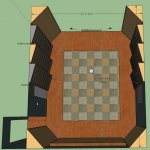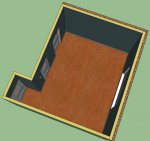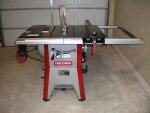Myriad_Rocker
New member
WARNING: This first post is what some might consider long winded. You have been warned.
WARNING 2: I can be sarcastic and dry. Deal with it.
This is an attempt to document the process of building the “Quasi Recording/Mix Room”. I hope you enjoy it, my random rants, and my infrequent victories. I’ve also started a blog (yes, I’m rather late to the game) and I’m going to use this room build to jump start it. Visit it if you like…I will probably post unrelated things there…thoughts, euphemisms, crazy ideas, whatever I think of...intertwined with this “project”.
Let me first start earlier in my recording endeavor. The previous house I lived in, I had a quasi-recording space. It was an upstairs bonus room with minimal treatment. I recorded an entire album with my band in that room. The results of that can be heard at Black Leaf Clover - Myspace Music
The wife and I decided to move into a new house…we were going to build. My initial plan was to build a building totally dedicated to recording. I had thought that I would make it a more serious hobby and parlay that into a recording career locally. I slaved over the plan for what seemed like forever. The plan I had was quite large by my standard. I “correctly” shaped control room with a good size live room. I had a full bath, lobby, and small entertainment area. There was storage off of the live room as well as a vocal booth. I went so far as to use ideal room sizes, 3 leaf wall construction, dedicated circuits, isolated grounding, one heck of an HVAC setup…etc, etc. Wood floors, proper treatment everywhere, the whole nine yards. It was epic.
Well, reality started to set in after we started churning some numbers with our builder. It wasn’t all that bad price wise, I thought, but the bank thought way differently. As far as they were concerned, it was just a garage. There was nothing in the area to compare something like this to. With that being said, it made the bank really hesitant on loaning on it. And we weren’t going to be able to come up with the cash to do it.
Long story short, we ended up firing that builder for other reasons and totally moving our lot selection. We went with another builder and went back to building the studio with the house on a larger lot...about 1.2 acres. We bought the lot and started running some numbers more in depth. Everything was coming out pretty well. Because I knew this particular builder, I was able to swing some deals and the house pre-appraisal was coming out well. However, we were really concerned that the equity coming from the house in addition to our down payment was not going to cover the cost of the studio. Again, the bank didn’t know how to value it. So they just called it a detached garage.
Well, the numbers didn’t work out…again. I wasn’t comfortable putting my family in that kind of situation even though I could have done it. So I moved to attach the studio to the actual house and scaled down the size. That way, the bank would have to consider it living space since it was attached to the house. I don’t recall the exact series of events after that but my plans just kept getting chopped and chopped. I made compromise after compromise until, finally, I basically got myself into a bedroom. Not even as large as the bonus room I had before. But at least I wasn’t upstairs anymore.
So, here I am…now in our new house that we moved into in August. It’s great and I love it. But I did have to make a lot of compromises on my “dream” of having a legit studio space. So, at this point, I’m just trying to make the best with the cards I’ve been dealt. And that’s what has lead me here.
As boring and brutal as this may be, I’m going to attempt to document this process as best I can. It may not be consistent as far as timeline but I’m going to attempt to continually give updates as much as I can, even if it is just thoughts about what I’m going to be doing next.
So, without further delay, here is the room I am starting with. There’s lots of junk in it right now. Most of it is recording and/or music related. Some of the gear in the room was gear I purchased when I thought I was going to have a larger studio and go full time. So, I probably have too many SM57’s and such like that than I need. And as soon as I wade through the mass amount of stuff, I’ll probably end up selling some of it; which could turn out to be a good thing because I can use that money to buy other shiny things that have lights on them!
Excuse my lack of picture taking skills.
WARNING 2: I can be sarcastic and dry. Deal with it.

This is an attempt to document the process of building the “Quasi Recording/Mix Room”. I hope you enjoy it, my random rants, and my infrequent victories. I’ve also started a blog (yes, I’m rather late to the game) and I’m going to use this room build to jump start it. Visit it if you like…I will probably post unrelated things there…thoughts, euphemisms, crazy ideas, whatever I think of...intertwined with this “project”.
Let me first start earlier in my recording endeavor. The previous house I lived in, I had a quasi-recording space. It was an upstairs bonus room with minimal treatment. I recorded an entire album with my band in that room. The results of that can be heard at Black Leaf Clover - Myspace Music
The wife and I decided to move into a new house…we were going to build. My initial plan was to build a building totally dedicated to recording. I had thought that I would make it a more serious hobby and parlay that into a recording career locally. I slaved over the plan for what seemed like forever. The plan I had was quite large by my standard. I “correctly” shaped control room with a good size live room. I had a full bath, lobby, and small entertainment area. There was storage off of the live room as well as a vocal booth. I went so far as to use ideal room sizes, 3 leaf wall construction, dedicated circuits, isolated grounding, one heck of an HVAC setup…etc, etc. Wood floors, proper treatment everywhere, the whole nine yards. It was epic.
Well, reality started to set in after we started churning some numbers with our builder. It wasn’t all that bad price wise, I thought, but the bank thought way differently. As far as they were concerned, it was just a garage. There was nothing in the area to compare something like this to. With that being said, it made the bank really hesitant on loaning on it. And we weren’t going to be able to come up with the cash to do it.
Long story short, we ended up firing that builder for other reasons and totally moving our lot selection. We went with another builder and went back to building the studio with the house on a larger lot...about 1.2 acres. We bought the lot and started running some numbers more in depth. Everything was coming out pretty well. Because I knew this particular builder, I was able to swing some deals and the house pre-appraisal was coming out well. However, we were really concerned that the equity coming from the house in addition to our down payment was not going to cover the cost of the studio. Again, the bank didn’t know how to value it. So they just called it a detached garage.
Well, the numbers didn’t work out…again. I wasn’t comfortable putting my family in that kind of situation even though I could have done it. So I moved to attach the studio to the actual house and scaled down the size. That way, the bank would have to consider it living space since it was attached to the house. I don’t recall the exact series of events after that but my plans just kept getting chopped and chopped. I made compromise after compromise until, finally, I basically got myself into a bedroom. Not even as large as the bonus room I had before. But at least I wasn’t upstairs anymore.
So, here I am…now in our new house that we moved into in August. It’s great and I love it. But I did have to make a lot of compromises on my “dream” of having a legit studio space. So, at this point, I’m just trying to make the best with the cards I’ve been dealt. And that’s what has lead me here.
As boring and brutal as this may be, I’m going to attempt to document this process as best I can. It may not be consistent as far as timeline but I’m going to attempt to continually give updates as much as I can, even if it is just thoughts about what I’m going to be doing next.
So, without further delay, here is the room I am starting with. There’s lots of junk in it right now. Most of it is recording and/or music related. Some of the gear in the room was gear I purchased when I thought I was going to have a larger studio and go full time. So, I probably have too many SM57’s and such like that than I need. And as soon as I wade through the mass amount of stuff, I’ll probably end up selling some of it; which could turn out to be a good thing because I can use that money to buy other shiny things that have lights on them!
Excuse my lack of picture taking skills.
Attachments
Last edited:








 Howdy Myraid and welcome to the "make do" club.
Howdy Myraid and welcome to the "make do" club.

 Also..there are TONS of tricks to learn. Just ask. After 40 years of woodworking I've learned a few.
Also..there are TONS of tricks to learn. Just ask. After 40 years of woodworking I've learned a few.


















 By the time you sell it, your gonna have to do a ton of spackling and painting anyway.
By the time you sell it, your gonna have to do a ton of spackling and painting anyway.